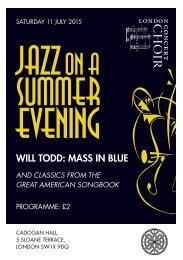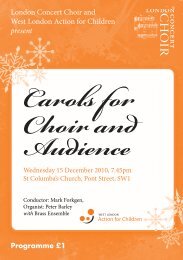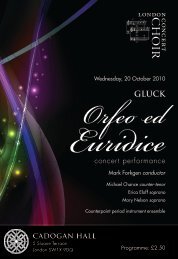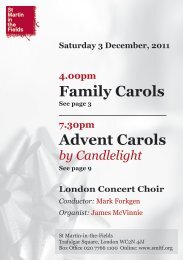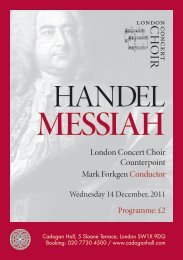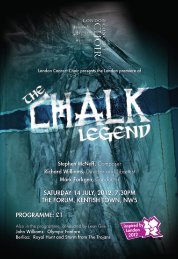11 November, 2015: Mozart Requiem
- No tags were found...
Create successful ePaper yourself
Turn your PDF publications into a flip-book with our unique Google optimized e-Paper software.
of speculation. But it is well-known that the composer had not thought much<br />
of Süssmayr’s abilities, calling him a ‘blockhead’. Yet Süssmayr had no qualms<br />
about finishing his teacher’s work. He received <strong>Mozart</strong>’s original score with<br />
Eybler’s additions and copied out his own version, using some of the work that<br />
Eybler had done. In addition, Constanze provided him with sketches and scraps<br />
of paper with <strong>Mozart</strong>’s ideas. Süssmayr finished the Lacrimosa but this left him<br />
with three entire movements, the Sanctus, Benedictus and Agnus Dei, which<br />
<strong>Mozart</strong> had not even begun work on.<br />
It must have been a daunting task, and musicians and critics have been arguing<br />
about the quality and authenticity of these movements ever since the 1820s<br />
when the so-called ‘<strong>Requiem</strong> controversy’ broke out. It seems likely that<br />
Süssmayr was not a composer able to execute the complex structural links and<br />
cross-references between movements that musicologists now believe <strong>Mozart</strong><br />
had planned for the whole work. The beauty of Süssmayr’s movements lies in<br />
the simple devotion that they express. They are not able to emulate the power of<br />
<strong>Mozart</strong>’s fugues, his daring juxtaposition of contrasts such as in the Confutatis,<br />
or his superb word painting as in the Dies irae and the Rex tremendae.<br />
In the final Communio Süssmayr decided to reuse <strong>Mozart</strong>’s music for the<br />
Introitus and Kyrie. Whether this was <strong>Mozart</strong>’s own idea, as Constanze claimed,<br />
is not documented. It was in her interest to convince the patron – and later the<br />
publisher – that the entire work was her husband’s. The finished manuscript was<br />
delivered to Count Walsegg in February 1792. He copied the score in his hand,<br />
adding his own name onto the title page, and directed his first performance of<br />
the <strong>Requiem</strong> in a liturgy in December 1793. Unbeknown to him, the completed<br />
work had already been performed from another existing copy in January of that<br />
year in Vienna, in a concert organized by Baron van Swieten for the benefit of<br />
Constanze <strong>Mozart</strong> and her children.<br />
Tonight’s performance relies on what has become the standard version of the<br />
<strong>Requiem</strong> with Süssmayr’s completions and additions. In its entirety it is a<br />
profoundly moving work that speaks to us about the transient nature of human<br />
life. Deeply devotional, it expresses trust in salvation, but also human feelings





